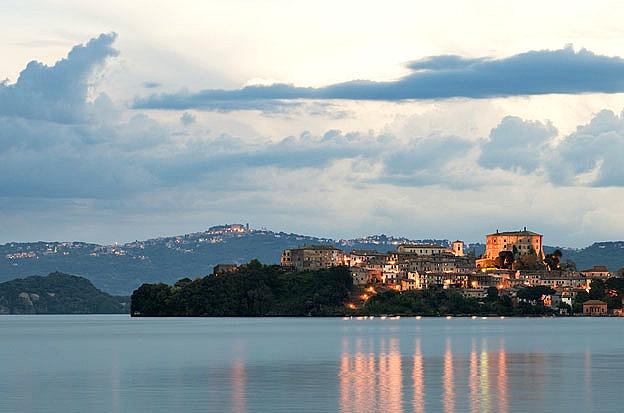Bolsena is a 'miraculous' lake in the Tuscia area, between Rome and Tuscany, which is dotted with enchanting towns that dominate the 'path of the Etruscans'. Rarely overcrowded, and abundant with beautiful black volcanic sands, it is the largest volcanic lake in Europe, with a circumference of 43km, and an incredible history. 370,000 years ago the collapse of land following the eruption of the Vulsini volcano (active until 104 BC) formed a caldera which then became the bed of Bolsena's lake. There are two islands, Bisentina and Martana, in the southern part of the lake which were formed by underwater eruptions following the collapse that created the caldera.
The area was part of the Etruscans territories in central Italy, a dominant culture in Italy by 650 BC. Needless to say, it's dowsed with tribe upon tribe which left their mark on this mysterious area.
Today the lake and the medieval town with the same name on its shores are best known for a miracle that occurred in medieval times in 1263.

The Miracle of Bolsena
In 1263, a Bohemian priest, Peter of Prague, was tormented by the doubt as to whether Christ was actually present in the consecrated Host and went on a pilgrimage to Rome to strengthen his faith.
On his way back, he stopped in the church of Saint Christina in Bolsena, and while celebrating Holy Mass above the tomb of St. Christina, he had barely spoken the words of Consecration when blood started to seep from the consecrated Host and trickle over his hands onto the marble altar and the corporal.
The priest interrupted the Mass and asked to be taken to Orvieto, the city where Pope Urban IV was then residing. The Pope listened to the priest's account and absolved him. When, after an investigation, all the facts were ascertained, he ordered the Bishop of the diocese to bring the Host and the linen cloth bearing the stains of blood to Orvieto.
The day archbishops, cardinals and other Church dignitaries brought them to Orvieto, the Pope met the procession and had the relics placed in the cathedral.
Apparently, Pope Urban IV was prompted by this miracle to commission St. Thomas Aquinas to compose the Proper for a Mass and an Office honoring the Holy Eucharist as the Body of Christ. One year after the miracle, in August of 1264, Pope Urban IV introduced the saint's composition, and by means of a papal bull instituted the feast of Corpus Christi.

The Mass at Bolsena by Raffaello - Apostolic Palace - The Vatican
In Bolsena, in the beautiful Church of Santa Cristina, there is a reliquary containing the marble, stained with blood, while the blood stained linen (exposed during the annual procession for the Feast of Corpus Domini) and the holy corporal are kept in a golden shrine in the Cathedral of Orvieto.
After visiting the Cathedral of Orvieto, many pilgrims and tourists go to visit St. Christina's Church in Bolsena to see the place where the miracle occurred. However, Bolsena is rarely overcrowded and an absolute pleasure to visit.
'Un Miracolo della Natura' - A Miracle of Nature
Covering an area of 113.5 km2, it is considered Europe’s largest volcanic basin. It is Italy’s fifth largest lake and the biggest in the Lazio region. The lake is simply unique, with its black volcanic sands and beaches stretching for several miles, and it is an ideal destination for swimming, picnicking, water sports and fishing.
It is also a bird watchers' paradise: black redstarts, pochards, red crested pochards, coots, great crested grebes, little grebes, egrets, and grey herons have all been spotted in the area. Sedentary birds include doves, seagulls, and swans. Then there are herons, reed warblers, and great reed warblers.

A perfect off-the-beaten track location
In between Rome and Tuscany, it's a gastronomical treat for the taste buds, without blowing the budget, with the bonus of being off the beaten 'Tuscany' tourist track.
Boasting a multitude of day trips to blow your mind, you would want a weekend and a car to make the most out of this discrete destination. Bolsena Town, Montefiascone, the Monaldeschi Fortress, Capodimonte are all interesting places to visit aroudn Bolsena Lake for their history and their local traditions.
The lake is a also stop on two major itineraries: Via Francigena (Bolsena was an important post/stop) and Sentiero dei Briganti – the “path of brigands” – that visits places of outlawry from Vulci to Acquapendente.

Drive to Bolsena from Rome
Lake Bolsena can be easily reached from Rome by taking the Cassia road. It can also be reached from the main A1 tollway motorway that connects Rome and Florence, by exiting at Orte or Orvieto.
Bolsena keeps visitors coming back for more. But, don't tell anyone about it, keep the miracle to yourself!














